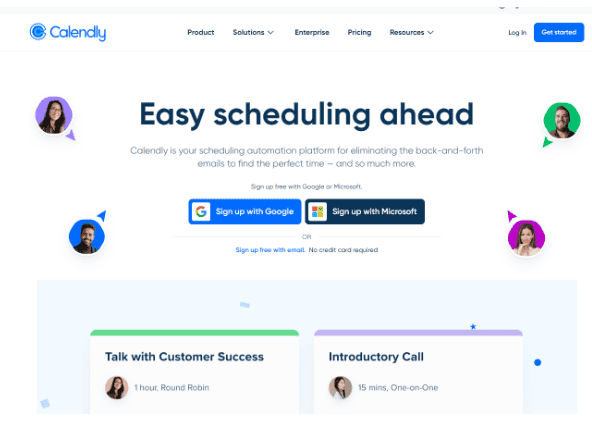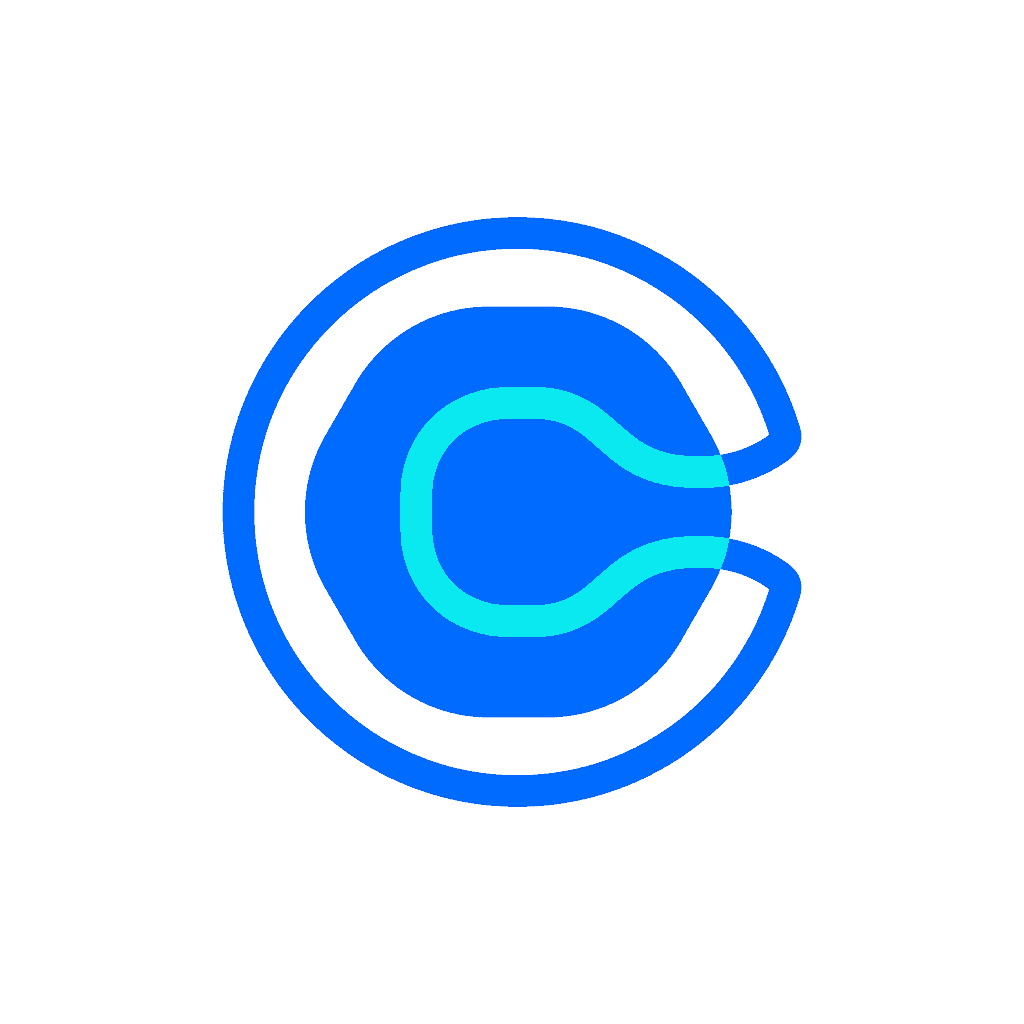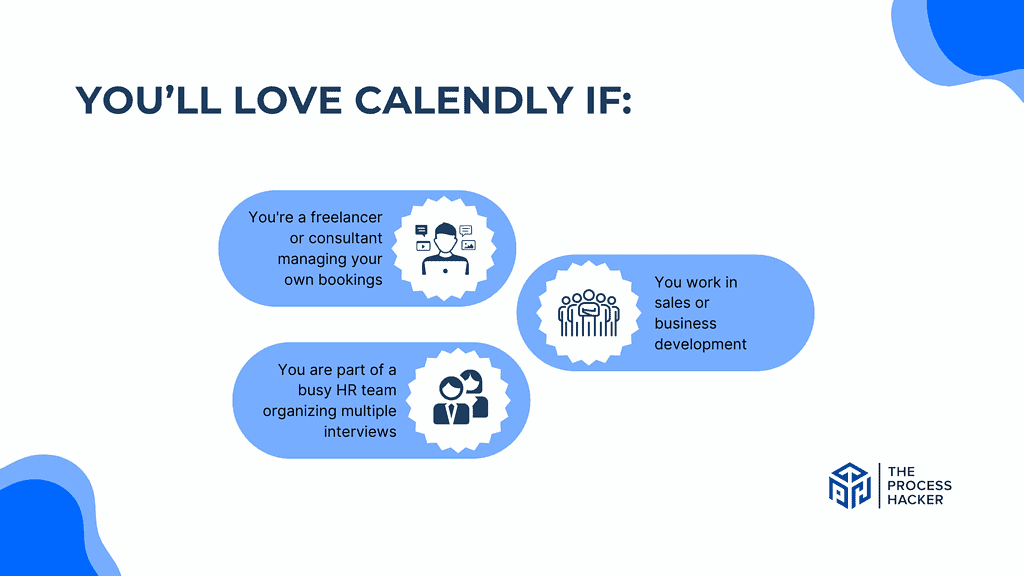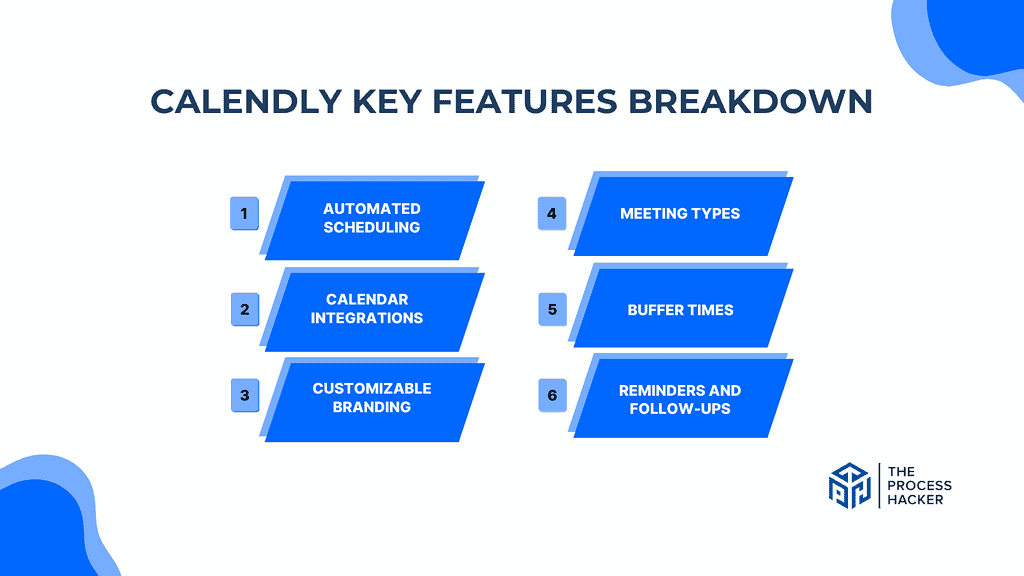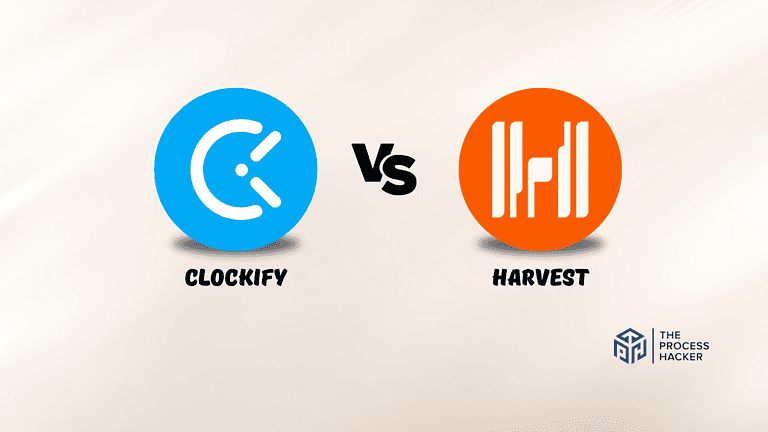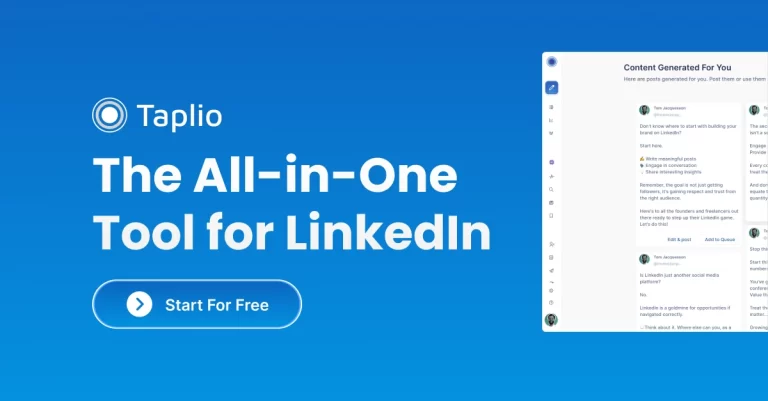Calendly Review 2024: Best Tool to Schedule Meetings?
Are you tired of the endless back-and-forth emails just to nail down a meeting time?
If so, you’re not alone. That’s where Calendly comes in, promising to streamline the scheduling process and reclaim your precious time. But does it live up to the hype?
As someone who has spent countless hours researching and testing various meeting scheduling tools, I’m here to share my firsthand experience with Calendly. I’ll provide an honest, in-depth assessment of its features, pricing, and overall effectiveness.
If you purchase through our partner links, we get paid for the referral at no additional cost to you! For more information, visit my disclosure page.
By the end of this review, you’ll clearly understand whether Calendly is the right fit for your needs. So, grab a cup of coffee and let’s dive into the details!
Calendly Pros and Cons
When considering a tool for scheduling meetings, it’s essential to weigh Calendly’s pros and cons against your specific needs and preferences to make the right decision.
Pros
Cons
Calendly Pros
- Time-Saving Automation: Calendly takes the hassle out of scheduling by letting you set your availability preferences once and then sharing a personalized link with others. They can then pick a time that works for them without any back-and-forth emails or phone calls. This can save you a significant amount of time and mental energy.
- Easy Integration with Your Calendar: Calendly seamlessly integrates with popular calendar apps like Google Calendar, Outlook, and iCloud. This means your availability is always up-to-date, preventing double bookings and ensuring a smooth scheduling experience for both you and the person you’re meeting with.
- Professional and Customizable Branding: Calendly allows you to customize your appointment booking page with your branding, including your logo, colors, and personalized messages. This adds a professional touch to your interactions and reinforces your brand identity with every meeting you schedule.
Calendly Cons
- Learning Curve for Advanced Features: While Calendly’s core functionality is intuitive, some advanced features like team scheduling or complex availability rules may require a bit of a learning curve. However, the platform offers excellent documentation and support to help you get the most out of it.
- Limited Customization on Lower-Tier Plans: The free plan offers basic functionality, but you’ll need to upgrade to a paid plan to unlock advanced features like custom branding, SMS notifications, and team scheduling. This might be a consideration for individuals or small businesses on a tight budget.
- Potential for No-Shows and Cancellations: Like any scheduling tool, Calendly doesn’t entirely eliminate the possibility of no-shows or last-minute cancellations. However, you can mitigate this by setting up automatic reminders and cancellation policies to encourage people to arrive on time or reschedule.
Quick Verdict – Is Calendly Worth the Money?
After spending numerous hours integrating Calendly into daily meeting workflows, it’s clear: Yes, it is worth the money.
The tool makes scheduling as effortless as possible, whether arranging one-on-one sessions or coordinating multiple team members.
The beauty of Calendly lies in its simplicity and efficiency. It automates appointment times based on your availability, eliminating the hassle of time zone conversions and preventing double bookings.
The ability to sync with multiple calendars is a game-changer, ensuring that you maintain a holistic view of your schedule. The personalized booking links are incredibly beneficial, allowing you to share your availability with just a link, which your contacts can use to book a time that works best for both parties.
You may hesitate, thinking Calendly might be too expensive. However, considering the amount of time and energy you can save from manually having to schedule appointments, it is worth it.
The basic features are good enough for most business needs. Further, the premium features, like automated reminders and customizable workflows, justify the extra expense by boosting your productivity further.
While Calendly is undoubtedly a powerful tool, it has limitations. For instance, it doesn’t have a user-friendly interface. It can be a bit rigid in terms of design customization. Those looking for a more branded experience might find this a slight drawback.
Ready to take your scheduling to the next level? Try Calendly today!
Who is Calendly for?
You’ll love Calendly if:
- You’re a freelancer or consultant managing your own bookings. Calendly’s ability to integrate with personal and professional calendars helps you avoid the hassle of double-booking and manage your appointments seamlessly.
- You work in sales or business development. If your role involves frequent meetings with clients, leads, or team members, Calendly can automate scheduling, letting you focus more on relationships and less on logistics.
- You are part of a busy HR team organizing multiple interviews. Calendly streamlines the coordination of numerous interview slots across various team members’ schedules, ensuring a smooth experience for both candidates and interviewers.
You won’t love Calendly if:
- You need a highly customized scheduling experience. If your priority has a tool that allows extensive customization to reflect your brand’s aesthetic directly on the booking page, Calendly’s straightforward interface might feel too rigid.
- You are looking for an all-in-one business management tool. Calendly focuses solely on scheduling and does not encompass broader business management features like invoicing or project management.
- You prefer in-person interactions to set meetings. If you value the personal touch of arranging meetings directly via phone or face-to-face interactions, using a digital scheduler like Calendly may feel too impersonal.
What is the Calendly?
Calendly is scheduling software designed to eliminate common inefficiencies in organizing meetings and appointments. It bridges your calendar with those seeking to book time with you, ensuring that everyone finds a suitable slot without the usual back-and-forth communication.
What is the key benefit of having a Calendly?
The standout benefit of Calendly is its ability to drastically reduce the time spent on scheduling. Automating the coordination process allows you to focus on more productive tasks, enhancing overall efficiency and reducing scheduling conflicts.
What does Calendly do?
Calendly integrates with your existing calendars to provide real-time availability to others, allowing them to book appointments based on predefined criteria you set. It comes with features like automatic time zone detection, customizable reminder emails, and follow-up notifications, all of which contribute to a streamlined scheduling process.
The platform supports one-on-one, round-robin, and group meeting setups, catering to various scheduling needs.
How is it different from competitors?
What sets Calendly apart from its competitors is its simplicity and the degree of integration it offers with a wide array of calendar services like Google Calendar, Outlook, and iCal. Unlike other tools that may require more manual input for each meeting type or less flexible integration, Calendly maintains a balance between functionality and user-friendliness.
Its sleek interface and robust automation capabilities make it a preferred choice for professionals across various industries, from healthcare to tech startups.
Reasons I Recommend the Calendly to Everyone
#1) Effortless Scheduling, Increased Productivity
Calendly eliminates the endless back-and-forth emails and phone calls that typically accompany scheduling. You simply set your availability, share your Calendly link, and let others choose a time that works for them.
This saves you time and presents a professional image to clients and colleagues. I’ve found that using Calendly has freed up my schedule, allowing me to focus on more important tasks.
#2) Customizable and Flexible for Your Needs
Calendly isn’t a one-size-fits-all tool. It offers a range of customization options, from setting buffer times between meetings to creating different meeting types for various purposes.
You can even embed your Calendly link on your website or social media pages for easy access. This level of flexibility ensures that Calendly adapts to your specific workflow and preferences.
#3) Seamless Integration with Your Favorite Tools
Calendly doesn’t exist in isolation. It integrates seamlessly with many popular tools like Google Calendar, Outlook, Zoom, and Salesforce.
This means you can automatically update your calendars, schedule video conferences, and even track leads—all from within Calendly. This integration has streamlined my entire scheduling process, making it more efficient than ever.
What You Might Not Like about Calendly
While Calendly brings a lot of benefits to the table, there are a few aspects that may not appeal to everyone. Here are a couple of downsides based on personal experiences that you might want to consider before deciding if Calendly is right for you:
#1) Limited Free Plan Functionality
Calendly’s free account, while a great starting point, comes with certain restrictions. You’re limited to one event type, which might be sufficient for individuals but could be restrictive for teams or businesses with diverse scheduling needs.
Additionally, some advanced features like group scheduling and integrations with certain tools are only available in paid plans. If you require more robust capabilities, you’ll need to upgrade, which can be a cost consideration for some.
#2) Learning Curve for Advanced Features
While Calendly’s basic functions are intuitive, mastering its advanced features might take some time and effort. Setting up complex workflows, customizing notifications, and integrating with various tools can be challenging for those who aren’t tech-savvy.
The learning curve can be a hurdle, especially for smaller teams without dedicated IT support. However, Calendly does offer comprehensive documentation and resources to help you get up to speed.
Calendly Pricing
Calendly offers a range of plans to fit different needs and budgets. You can get started with a free plan, perfect for individuals with basic scheduling requirements. If you need more features, the Standard plan costs $12 per person per month and provides enhanced customization and integrations.
Calendly offers Teams and Enterprise plans with even more advanced capabilities for larger teams and businesses. Whether you’re a solopreneur or a large organization, Calendly has a pricing option to accommodate you.
Calendly: Key Features Breakdown
Automated Scheduling
Automated scheduling is the heart of Calendly. It allows you to create a personalized booking page based on your availability. Others can then view your schedule and select a time that works for them without any back-and-forth communication.
Calendly’s automated scheduling stands out due to its simplicity and flexibility. You have complete control over your availability, setting specific time slots, durations, and even buffer times between meetings.
You can also create different meeting types for various purposes, such as consultations, demos, or team meetings. The ability to embed your Calendly link on your website or social media pages makes it incredibly accessible for others to book appointments.
Calendly’s automated scheduling has been great for me. I spent countless hours coordinating meeting times, often leading to frustration and delays.
With Calendly, I simply send my booking link, and clients or colleagues can easily schedule a meeting that fits both of our calendars. This has freed up so much of my time, allowing me to focus on more important tasks. It’s also improved my professionalism, as clients appreciate the convenience and efficiency of self-scheduling.
Calendar Integrations
Calendly seamlessly integrates with your existing calendar applications, such as Google Calendar, Outlook, iCloud, and Office 365. This means your availability is automatically synced, ensuring that only the time slots that are truly open in your calendar are offered to others. When someone books a meeting, the event is automatically added to both your calendar and theirs, eliminating double bookings and conflicts.
Calendly’s calendar integrations are unique in their ability to sync seamlessly and in real-time across multiple platforms. This eliminates the need for manual updates and ensures that your availability is always accurate. Additionally, Calendly intelligently checks for conflicts across all your connected calendars before allowing someone to book a time, preventing any scheduling mishaps.
As someone who juggles multiple calendars for both work and personal commitments, Calendly’s calendar integrations have been amazing.
I no longer have to worry about double-booking myself or manually updating my availability across different platforms. Calendly takes care of all that for me, giving me peace of mind that my schedule is always accurate and up-to-date.
Customizable Branding
Calendly’s customizable branding allows you to tailor your scheduling page to reflect your unique style and professionalism. You can add your logo, choose your brand colors, and even customize the URL of your booking page. This ensures that your scheduling experience is consistent with your overall brand identity, creating a seamless and cohesive impression for anyone booking a meeting with you.
Unlike many other scheduling tools that offer generic and impersonal booking pages, Calendly empowers you to take control of your brand image. This is particularly important for businesses and professionals who want to maintain a consistent look and feel across all customer touchpoints. With Calendly, your scheduling page becomes an extension of your brand, reinforcing your professionalism and attention to detail.
I’ve found that Calendly’s customizable branding has elevated my client interactions. My booking page now looks polished and professional, aligning perfectly with my brand’s visual identity.
This has not only impressed clients but also instilled a sense of trust and credibility. It shows that I care about the details and am committed to providing a top-notch experience from the very first interaction.
Meeting Types
Calendly’s Meeting Types feature allows you to create different types of meetings for various purposes. You can customize the duration, location (in-person or virtual), description, and even the questions asked when someone books a meeting. For example, you could have one meeting type for 15-minute discovery calls, another for 60-minute consultations, and yet another for team brainstorming sessions.
Calendly’s Meeting Types is a standout feature because it provides a level of customization that goes beyond simple scheduling. It allows you to tailor the entire booking experience to the specific type of meeting, making it more relevant and efficient for both you and the person booking. This especially benefits businesses and professionals offering various services or consultations.
Meeting Types has been a game-changer for my workflow. I used to struggle with managing different types of appointments and ensuring that each had the appropriate time allotted and relevant information collected.
I’ve created distinct meeting types for each of my services. Calendly’s streamlining scheduling process ensures that I’m always prepared for the type of meeting I’m having. It’s made my scheduling more organized and my client interactions more focused.
Buffer Times
Buffer times are intervals you can set before or after your meetings. These breaks allow you to prepare for the next meeting, wrap up the previous one, or simply catch your breath. You can customize the buffer time duration based on your preferences, ensuring you have enough time between appointments.
Calendly’s buffer times are a godsend for those who have back-to-back meetings. Instead of rushing from one meeting to the next, feeling frazzled and unprepared, buffer times create a sense of calm and control in your schedule. This feature is particularly valuable for those who need a few minutes to transition between different tasks or simply need a moment to recharge.
Buffer times have been excellent for someone who dreaded the constant hustle of consecutive meetings. I can now schedule calls, appointments, or my day confidently, knowing I have those valuable few minutes to gather my thoughts, review materials, or grab a coffee.
This has drastically reduced my stress levels and improved the overall quality of my meetings. It’s a small feature, but it’s significantly impacted my productivity and well-being.
Reminders and Follow-Ups
Calendly’s Reminders and Follow-Ups feature automatically sends email or text notifications to you and the person you’re meeting. These notifications can be customized to your liking, reminding everyone of the upcoming meeting, providing important details, or even requesting confirmation.
Calendly’s reminder system goes beyond simple notifications. It can be tailored to send reminders at specific intervals before the meeting, reducing the likelihood of no-shows. Additionally, follow-up emails can be automated to gather feedback, send additional information, or simply thank someone for their time. This level of automation eliminates manual tasks and ensures that everyone stays informed and engaged.
Before Calendly, I spent a considerable amount of time sending out individual reminders and follow-up messages. It was a tedious process that often slipped through the cracks.
With Calendly’s automated reminders and follow-ups, I’ve noticed a significant reduction in no-shows and missed appointments. It’s also improved client communication, as they receive timely reminders and feel more connected to the scheduling process.
FAQs about Calendly
Calendly is a robust scheduling tool that simplifies meeting coordination. Here are some frequently asked questions that can help you understand it better:
How do I set up my availability on Calendly?
To set up your availability, navigate to the availability settings in your account. Here, you can create weekly, bi-weekly, or monthly schedules and apply these to your event types. You can also adjust start times, set maximum daily limits, and prevent last-minute bookings, among other settings.
What integrations does Calendly offer?
Calendly integrates with a wide range of services to enhance productivity and streamline scheduling. These include popular tools like Google Calendar, Outlook Calendar, Salesforce, Zoom, and many more. This allows you to keep all your scheduling and client information in sync.
How does Calendly handle different time zones?
Calendly includes automatic time zone detection, which ensures everyone sees the meeting time in their local time zone, eliminating confusion and reducing scheduling errors.
Can I change the email associated with my Calendly account?
Yes, you can change your login email from the account settings page. For those using SAML SSO for login, changes must be coordinated with your IT administrator.
What kind of customer support does Calendly offer?
Calendly provides a comprehensive help center with resources to assist users. Paid plans offer expedited support, including faster email responses and access to live chat, depending on the subscription level.
Can I customize my Calendly booking appointments page?
Yes, Calendly allows you to customize your booking page with your branding, including your logo, colors, and even custom URLs. This helps create a professional and consistent experience for your clients.
Does Calendly offer a mobile app?
Yes, Calendly has a mobile app available for both iOS and Android devices, allowing you to manage your schedule and bookings on the go.
Can I embed my Calendly link on my website?
Absolutely! Calendly provides easy-to-use embed codes that allow you to add your booking link directly to your website or social media pages.
Final Verdict – to Buy Calendly or Not to Buy Calendly?
After a thorough research and experience with Calendly, I recommend it, especially if you’re seeking an efficient, streamlined tool to handle your scheduling needs.
Its robust features, like automated scheduling, time zone intelligence, and customizable reminders, significantly enhance productivity by simplifying meeting coordination. This makes Calendly an indispensable asset for professionals, freelancers, and teams operating in today’s fast-paced environment.
While some may hesitate due to its premium features requiring a subscription, the return on investment in terms of time and reduced hassle is huge. Additionally, the limited customization options might not suit those needing a heavily branded scheduling page, but for the majority, Calendly’s functionality overshadows these minor drawbacks.
Don’t let scheduling be a bottleneck in your productivity any longer. Try Calendly today and experience firsthand how it can transform your time management!
While Calendly fits a pletora of scheduling needs, it’s wise to consider alternatives that might align more closely with specific requirements. Check out the next section, where we’ll explore other scheduling tools that offer different features.
Calendly Alternatives
If you need a different solution, consider one of these alternatives.
#1) Google Calendar
Many are already familiar with Google Calendar, a widely used, free calendar app. It’s great for basic scheduling and integrating with other Google Workspace tools. However, it lacks the advanced features of Calendly, such as automated scheduling, customizable branding, and extensive integrations with third-party apps.
Google Calendar is a solid choice if you’re looking for a simple, free calendar app for personal use or basic scheduling. But if you need a more robust tool for professional scheduling and managing appointments.
#2) Notion Calendar
Notion Calendar is a relatively new player in the scheduling space, but it’s gaining popularity for its minimalist design and integration with the Notion workspace.
It’s an excellent option for those using Notion for project management or note-taking. However, it lacks the specialized scheduling features that Calendly offers, such as buffer times, customizable meeting types, and advanced integrations.
If you’re a Notion power user looking for a basic calendar within your workspace, Notion Calendar is a good option. But if you need a dedicated scheduling tool with more features, Calendly is the way to go.
#3) Acuity Scheduling
Acuity Scheduling is another popular scheduling tool, known for its sleek and user-friendly interface. It offers a wide range of features, from appointment customization to team scheduling.
One unique feature of Acuity is the ability to accept payments directly through the platform. This can be useful for businesses that offer services with varying prices or require upfront payment.
However, Acuity does not have as many integrations as Calendly and can be more expensive for larger teams. Overall, Acuity is a strong option for service-based businesses looking for an alternative all-in-one scheduling solution.
#4) Motion
Motion is a newer AI-powered scheduling app that streamlines the process of booking tasks, appointments, and meetings. Designed with a clean and user-friendly interface, Motion eliminates the need for back-and-forth emails or phone calls to coordinate availability.
While similar in function to Calendly, Motion excels in its ability to move events around on your calendar. Additionally, Motion integrates seamlessly with other apps, such as Google Calendar and Zoom.
Overall, Motion is a strong option for individuals or small businesses looking for an efficient and customizable scheduling tool. With its AI capabilities, Motion takes the hassle out of scheduling so that you can focus on what matters most – your work.

